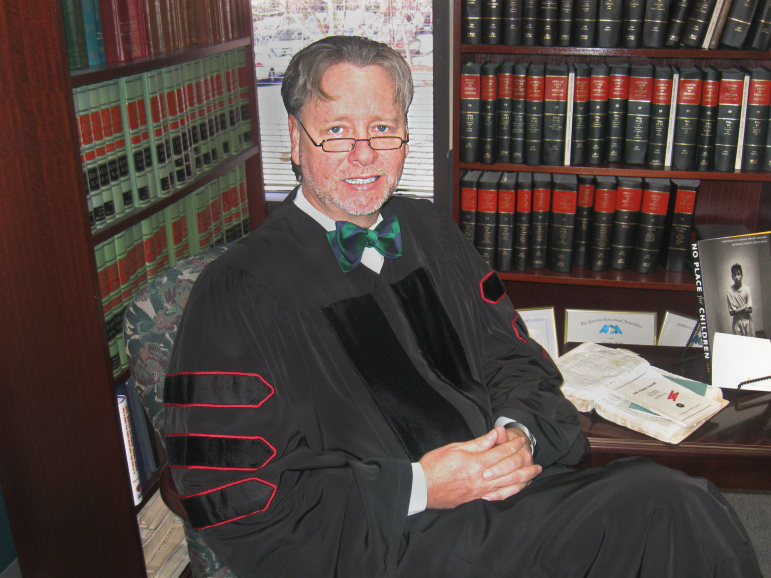 I had just concluded a lecture at Emory University College of Law on zero tolerance policies and the law when, coincidentally, the chief of police of our school police department called.
I had just concluded a lecture at Emory University College of Law on zero tolerance policies and the law when, coincidentally, the chief of police of our school police department called.
“Judge,” he began. “We have a problem at one of our high schools—a gang is terrorizing staff and students.”
The chief described a recent development of brazen assaults by a group of students on other students in the cafeteria and other common areas of the school. They were “flashing” gang signs during the assaults and worse—they were apathetic to who was watching, including teachers and administrators.
This arrogant and apathetic disposition accompanied by a “flashy” demeanor became more evident when confronted by principals—they shamelessly admitted gang involvement. Some went further—no one, they said, “was going to tell us what to do.”
Clayton County was the first community in the nation to forge a cooperative agreement to reduce school arrests, which are down 83 percent since its execution in 2004. Many have touted our approach—now referred to as the Positive Student Engagement Model for School Policing—as a better practice in lieu of the harsh disciplinary responses exacted by many educators still supporting zero tolerance policies.
Understanding the effectiveness of our cooperative model—improved student and police relations leading to increased student intel that results in prevention and solving of crimes—is to understand that we embraced zero tolerance using a common sense approach.
The problem with zero tolerance is in its application, not the concept. The use of zero tolerance is analogous to the Overbreadth Doctrine applied in free speech cases—a law intended to prohibit harmful speech that includes language so broad that it also prohibits protected speech is unconstitutional. The same holds true in principle involving zero tolerance policies; they are overbroad and more hurtful than helpful.
Today, zero tolerance is synonymous with suspension, expulsion and arrest regardless of the severity of the offense. It is not unusual for male students who duke it out over a girl to get the same consequences as those students who duke it out over a gang rivalry.
The result: zero tolerance becomes zero intelligence!
This failure to distinguish behavior that is derived from adolescent immaturity and that which is delinquent results in frivolous complaints referred to the court that diverts resources from the dangerous cases and in turn dilutes the effectiveness of court supervision. Many misdemeanor offenses characterized as “typical juvenile behavior” should not invoke juvenile court jurisdiction. Youth are still under neurological construction that diminishes their capacity to possess a criminal mind involving less serious matters.
Law Professor James E. Westbrook wrote that juvenile courts should be careful not to look for business, saying, “. . . There are a sufficient number of really hard cases for the courts to concern themselves with without reaching out for more business.” He concludes by saying, “If the courts assume too great a load, their effectiveness could be seriously hampered,” and argues that requiring the showing of mens rea “can be an effective tool in weeding out cases where the jurisdiction of the juvenile court should not be invoked.”
This was written in 1965, when fundamental concepts such as mens rea, right to counsel, and other due process requirements were foreign to the juvenile justice system. Shortly thereafter, In re Gault obliged Professor Westbrook, and for nearly 47 years these concepts have been imbedded in the adjudication stage of juvenile justice.
Why after all these years are courts wrestling with an increase in “business” from schools, of which most are attributed to “typical juvenile behavior?”
Einstein’s observation that “We cannot solve our problems with the same level of thinking that created them,” explains why this problem persists—zero tolerance policies were created out of convenience and so we search for convenient solutions that don’t exist.
So long as there are educators, there will be zero tolerance policies. The only solution is to say “No” by using the tools Gault gave us.
When I gathered our school and police leaders in 2003 to negotiate our stakeholder agreement, I told them “No more!”—but I needed their help to define the “No more!”
We agreed that criminal intent within the juvenile context needed definition—that “kids are kids.” This discussion at the outset forced us to be strategic by shielding from arrest specific misdemeanor offenses that are characterized as “typical” for adolescent behavior. We called them “Focused Acts.”
Despite this bright line, the Focused Acts included an exception: the shield is lost if the offense is masking an underlying serious issue in need of supervision and treatment—the legal definition of a delinquent child.
My conversation with the chief was brief. “The solution is in the agreement!” Three students were arrested; the conduct masked serious underlying issues.
The response was strategic—targeting the wolves and not the sheep. The school is quiet, except for the disruptions arising from “typical juvenile behavior” that 10 years ago resulted in handcuffs.
A veteran school police officer once told me, “If the only tool is a cop, than every problem becomes a crime.”
